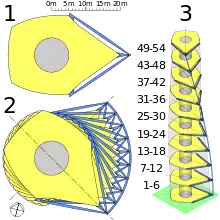Turning Torso
Turning Torso is a neo-futurist residential skyscraper in Sweden and the tallest building in Scandinavia.[5]
| Turning Torso | |
|---|---|
 Turning Torso, the tallest building in Scandinavia | |

| |
| General information | |
| Type | Commercial office Rental apartments |
| Architectural style | Neo-Futurism |
| Location | Lilla Varvsgatan 14, 211 15 Malmö, Sweden |
| Coordinates | 55°36′48″N 12°58′35″E |
| Construction started | 14 February 2001 |
| Completed | 27 August 2005 |
| Opened | 1 November 2005 |
| Inaugurated | 27 August 2005 |
| Height | |
| Roof | 190 m (623 ft) |
| Top floor | 178.79 m (586.58 ft) |
| Technical details | |
| Floor count | 54 |
| Floor area | 27,500 m2 (296,008 sq ft) |
| Lifts/elevators | 5 |
| Design and construction | |
| Architect | Santiago Calatrava |
| Main contractor | NCC |
| References | |
| [1][2][3][4] | |
Located in Malmö on the Swedish side of the Öresund strait, it was built and is owned by Swedish cooperative association HSB. It is regarded as the first twisted skyscraper in the world.[6]
The project was designed by Spanish architect, structural engineer, sculptor and painter Santiago Calatrava and officially opened on 27 August 2005. The tower reaches a height of 190 metres (623 ft) with 54 storeys and 147 apartments.[7]
In August 2015, it was announced that the building was the winner of the 10 Year Award from the Council on Tall Buildings and Urban Habitat.[8] It won the 2005 Gold Emporis Skyscraper Award.
Design
Turning Torso is based on a sculpture by Calatrava, called Twisting Torso, which is a white marble piece based on the form of a twisting human being. It is the first "twisting" tower.[9]
In 1999, HSB Malmö's former managing director, Johnny Örbäck, saw the sculpture in a brochure presenting Calatrava in connection with his contribution to the architectural competition for the Öresund Bridge. It was on this occasion that Örbäck was inspired to build HSB Turning Torso. Shortly afterwards he travelled to Zurich to meet Calatrava, and ask him to design a residential building based on the idea of a structure of twisting cubes.[10]

This is a solid, immobile building constructed in nine segments of five-story pentagons that twist relative to each other as it rises; the topmost segment is twisted 90 degrees clockwise with respect to the ground floor. Each floor consists of an irregular pentagonal shape rotating around the vertical core, which is supported by an exterior steel framework. The two bottom segments are intended as office space. Segments three to nine house 147 apartments.
Construction
Construction started in the summer of 2001. One reason for building Turning Torso was to re-establish a recognisable skyline for Malmö since the removal in 2002 of the Kockums Crane, which was located less than one kilometre (0.62 mi) from Turning Torso. The local politicians deemed it important for the inhabitants to have a new symbol for Malmö in lieu of the crane that had been used for shipbuilding and somewhat symbolised the city's blue collar roots.[10]
The construction of part of this building was featured on Discovery Channel Extreme Engineering TV programme which showed how a floor of the building was constructed.
Prior to the construction of Turning Torso, the 86-metre (282 ft) Kronprinsen had been the city's tallest building.[11]
The apartments were initially supposed to be sold, but insufficient interest resulted in the apartments being let. The owner has several times unsuccessfully tried to sell the building. The construction costs were almost double the estimate.
Events
On 18 August 2006, Austrian skydiver Felix Baumgartner parachuted onto the Turning Torso, and then jumped off it.[12]
Floor 49 is home to the public observation deck while floors 50–52 contain a private club, meeting events, the reception, and the venue restaurant.
Floor 53 and 54 in the Turning Torso are conference floors booked and managed by Sky High Meetings. Since 2009 the owner, HSB, has decided to let the public visit these floors but only on special scheduled days, and pre-booking is required.
Gallery
 Construction in 2004
Construction in 2004 Main entrance
Main entrance Top floors
Top floors Aerial view
Aerial view View from the ground level
View from the ground level View at night
View at night
See also
- List of tallest buildings in the world
- List of tallest buildings in Europe
- List of tallest buildings in Sweden
- List of twisted buildings
- Shanghai Tower, much larger twisting building
Notes
- (1) shows a typical floor plan, where the grey circle denotes the core and blue shapes denote the steel framework. (2) shows the way the nine segments fit around the core, and (3) is a dimetric projection of the tower.
References
- "Turning Torso". CTBUH Skyscraper Center.
- Turning Torso at Emporis
- "Turning Torso". SkyscraperPage.
- Turning Torso at Structurae
- "Santiago Calatrava's Turning Torso Wins Council on Tall Buildings and Urban Habitat's 10 Year Award". Architect. 2015-08-07. Retrieved 2017-02-18.
- "Twisting Tall Buildings". CTBUH. August 2016. Retrieved 2017-02-05.
- "The Turning Torso, Santiago Calatrava's Revolutionary Twisting Skyscraper in Sweden". Archute. 23 January 2016. Retrieved 20 October 2017.
- "CTBUH Announces 10 Year Award Winner for 2015". CTBUH. Retrieved 11 August 2015.
- Miller, Meg (25 August 2016). "Charting The Rise Of A New Trend In Skyscraper Design". Fastcodesign. Retrieved 26 August 2016.
- "HSB Website". HSB Website. Archived from the original on 27 September 2011. Retrieved 7 August 2011.
- Mapes, Terri. "The Turning Torso in Malmo, Sweden". About.com. Retrieved 24 February 2013.
- "Felix Baumgartner jumps from Turning Torso". YouTube. Retrieved 5 December 2010.
External links
| Wikimedia Commons has media related to Turning Torso. |
